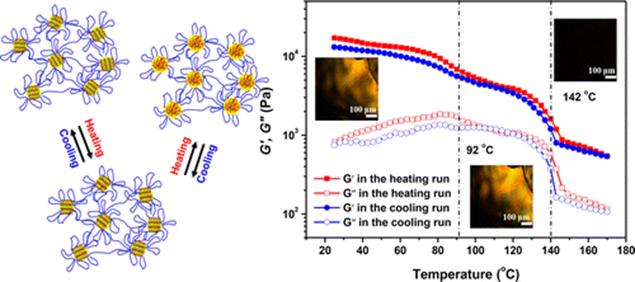Ion gels are made from polymeric networks swollen in ionic liquids (ILs). Recently they have attracted a great deal of attention because of their stability, non-volatility, high conductivity, and simulative responsiveness. They are widely used in electronics, actuators, and gas separation. A research group from the Department of Polymer Science and Engineering in the College of Chemistry and Molecular Engineering at Peking university has prepared thermo-responsive ion gels from ABA triblock copolymers containing a side-chain liquid crystalline (LC) as end-block A and poly(ethylene oxide) (PEO) as the mid-block B. Their research has been published in Macromolecules on July 28, 2015. The group synthesized ABA triblock copolymers, AOA-n (n = 0, 12, where n is the number of carbons in the side-chain spacer), and prepared ion gels by mixing the triblock copolymers with a room-temperature IL, 1-ethyl-3-methylimidazolium bis(trifluoromethylsufonyl)imide ([EMIM][TFSI]). The triblock copolymer AOA-12 with a long spacer shows liquid crystallinity, while AOA-0 is not liquid crystalline. The microphase-separated nanostructure of the ion gels with relatively high concentrations of AOA-12 changes with the concentration of the polymer. By incorporating the azobenzene mesogen in the side chains, transparent AOA-n/[EMIM][TFSI] ion gels are obtained with concentrations of the polymer as low as around 2 wt%. The ion gels obtained have storage moduli as high as ∼10 kPa, while the conductivities are close to that of the pure IL. Furthermore, the storage modulus of the AOA-12/IL ion gel can be tuned by temperature because of the thermotropic phase behavior of the LC block. 
The thermo-responsiveness of both the storage modulus and the loss modulus of the AOA-12/IL ion gel is correlated with the phase transition of the LC polymer in the ABA triblock copolymer. In the work,because of the relatively low concentration of the liquid crystalline block in the ionic gels, it was difficult to analyze the them using the in-house X-ray equipment. Synchrotron radiation of the beamline 1W2A at BRSF played an important role in the resolution of two key problems. On the one hand, the diffraction peak with q = 1.83 nm−1 corresponding to the LC ordering is also present in the ionic gels, implying that the LC phase of the LC polymer is retained in the ion gels. On the other hand, temperature-dependent SAXS measurements during heating from 30 to 150 °C were also conducted on the AOA-12/IL samples, and the SAXS profiles are barely changed throughout the entire experimental temperature range, indicating that the nanostructures of the ion gels remain unchanged and that the change in the storage modulus of the ion gel is correlated with the phase transition of the LC block. Prof. Zhihao Shen in the Department of Polymer Science and Engineering of the College of Chemistry and Molecular Engineering at Peking University believes that the abovementioned ion gels are potentially useful as high-temperature ionic membranes or thermal-responsive soft actuators. Article: Yudong Zhang, Xinghe Fan, Zhihao Shen, Qifeng Zhou Thermoreversible Ion Gel with Tunable Modulus Self-Assembled by a Liquid Crystalline Triblock Copolymer in Ionic Liquid. Macromolecules 48(2015), 4927–4935. |


